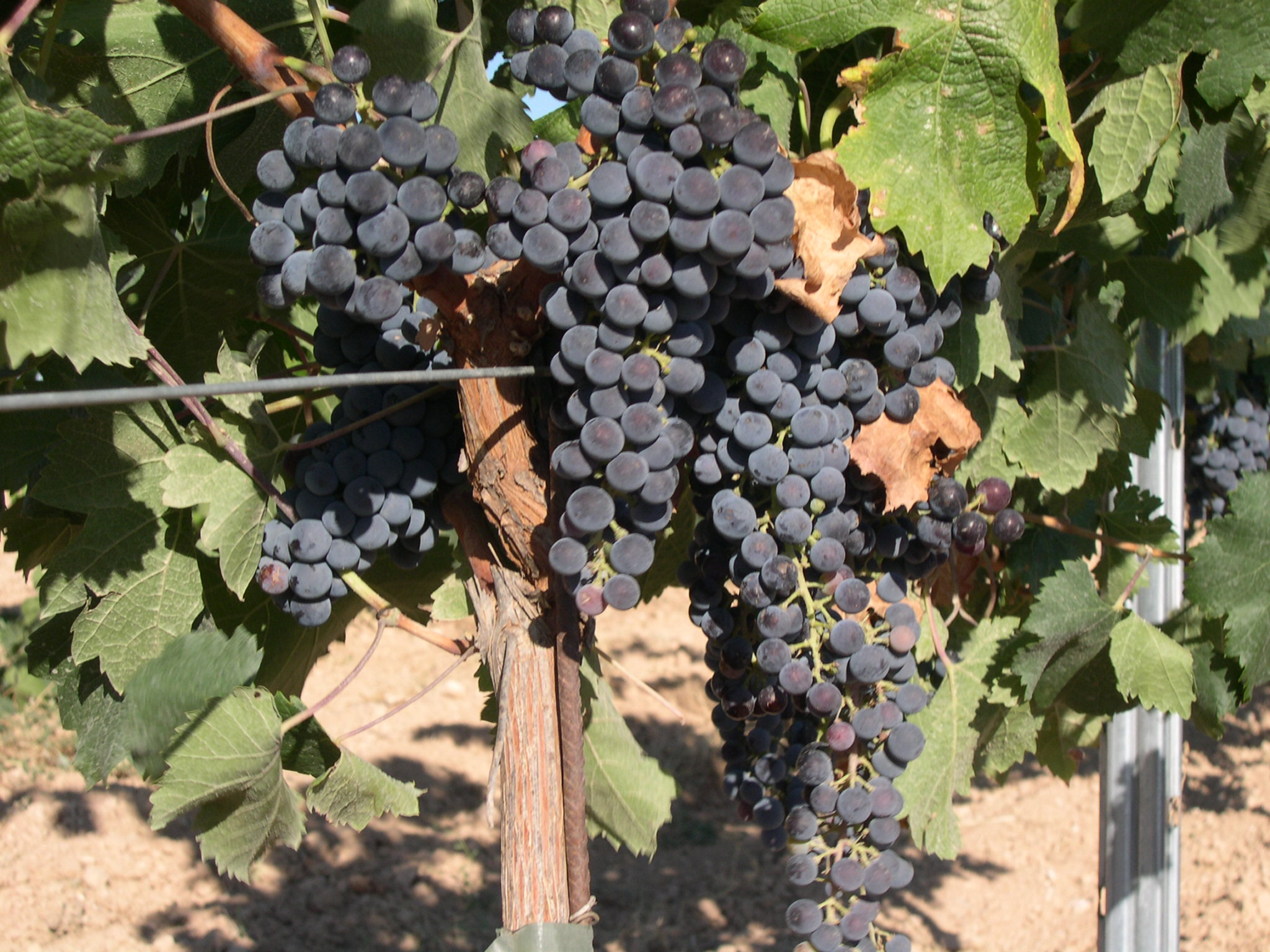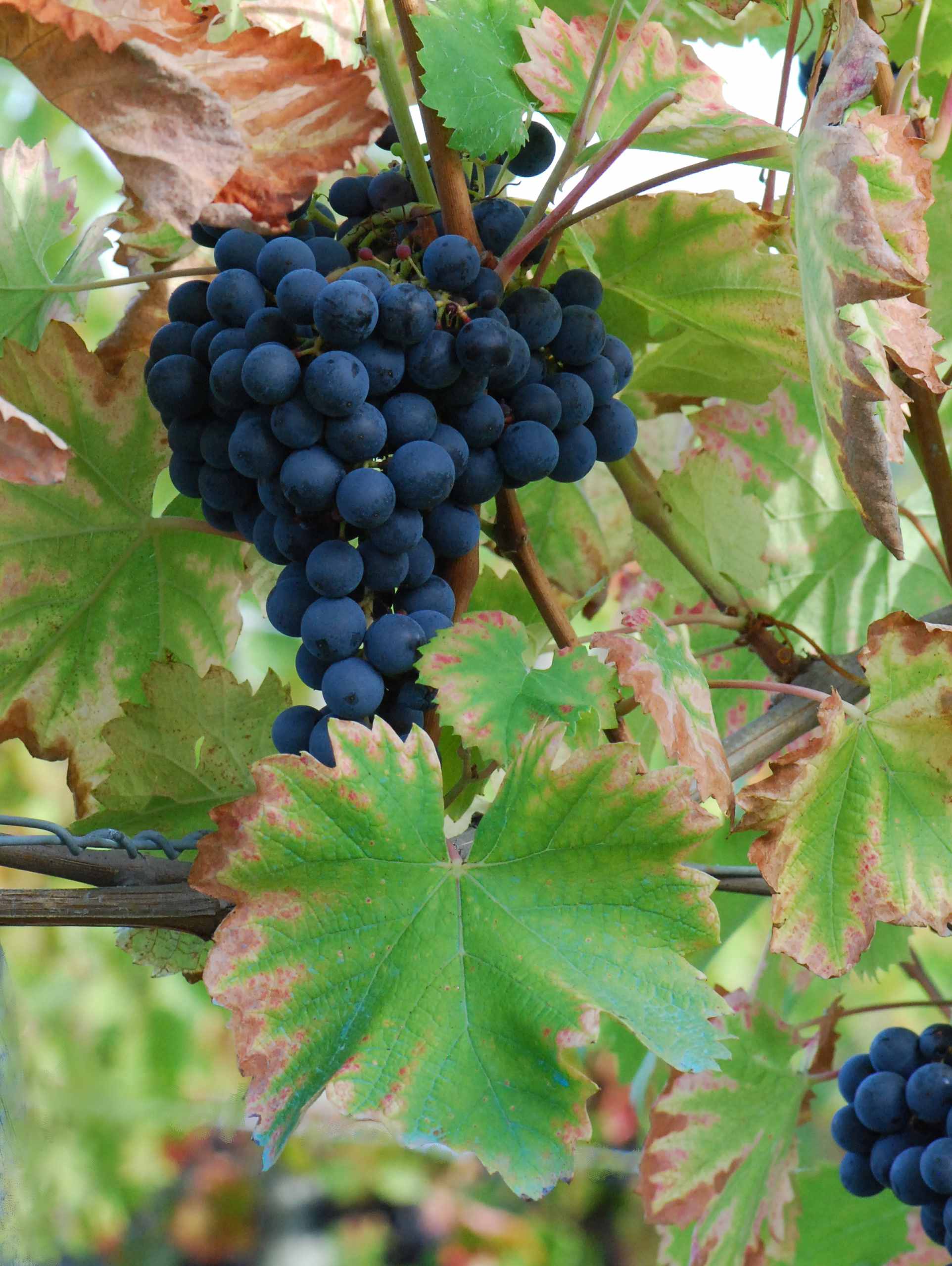Vermentino (TCVS A) is a late-ripening Italian white grape variety that’s widely planted in Sardinia, Liguria, Pigato, and to a lesser extent Corsica. It can be used to make a wide variety of white wines, including sweet and sparkling.
The “TCVS A” clone of Vermentino planted at CRV is a Tablas Creek Vineyard clone that originated in Sardinia.
Photo by Magnetto (CC-BY-SA-3.0 ), via Wikimedia Commons
Petit Manseng (TCVS A) is a white wine grape variety that is grown primarily in South West France. The name is derived from its small, thick skin berries. The grape is often left on the vine to produce a late harvest wine made from its nearly raisin like grapes.

Photo by Jymm [Public domain], via Wikimedia Commons
Roussanne (468 E) and Marsanne are known as the French Sisters since they are grown in the same regions of France and frequently blended to produce food friendly white wines. The berries are distinguished by their russet color when ripe — roux is French for the reddish brown color russet, and is probably the root for the variety’s name. The aroma of Roussanne is often reminiscent of a flowery herbal tea. In warm climates, it produces rich full-bodied wines, with flavors of honey and pear.
Marsanne (FPS 03) is a white wine grape most commonly found in the Northern Rhône region of France. It is often blended with Roussanne. In Savoie the grape is known as grosse roussette. Outside France it is also grown in Switzerland (where it is known as ermitage blanc or just ermitage), Spain (where it is known as Marsana), Australia and the United States.
Merlot (FPS 03) is a dark blue-colored wine grape that is used as both a blending grape and for varietal wines. The name Merlot is thought to be a diminutive of merle, the French name for the blackbird, probably a reference to the color of the grape. Merlot-based wines usually have medium body with hints of berry, plum, and currant. Its softness combined with its earlier ripening, makes Merlot a popular grape for blending with the sterner, later-ripening Cabernet Sauvignon, which tends to be higher in tannin.

Photo property of David Carrero Fernández-Baillo (CC-BY-SA-3.0 ), via Wikimedia Commons
Cabernet Sauvignon (FPS 04) is one of the world’s most widely recognized red wine grape varieties. It became internationally recognized through its prominence in Bordeaux wines where it is often blended with Merlot and Cabernet Franc. From France, the grape spread across Europe and to the New World. This variety was produced through a chance crossing of Sauvignon Blanc and Cabernet Franc during the 17th century.
Tempranillo (FPS 02) is a variety of black grape widely grown to make full-bodied red wines in its native Spain. Its name is the diminutive of the Spanish temprano (“early”), a reference to the fact that it ripens several weeks earlier than most Spanish red grapes. It is the main grape used in Rioja, and is often referred to as Spain’s noble grape. Often blended with Grenache and Cariñena (known in Rioja as Mazuelo), Tempranillo is bottled either young or after several years of barrel aging. In Portugal, it is blended with others to produce port wine. Often growing its best at higher altitudes, the grape yields wines that are ruby in color, with aromas and flavors of berries, plum, tobacco, vanilla, leather and herb.
Sangiovese (VCR06) is a red Italian wine grape variety whose name derives from the Latin sanguis Jovis, “the blood of Jove”. Though it is the grape of most wines of central Italy from Romagna down to Lazio, Campania and Sicily, outside Italy it is most famous as the main component of the blend Chianti, Carmignano, Vino Nobile di Montepulciano and Morellino di Scansano, although it can also be used to make varietal wines such as Brunello di Montalcino, Rosso di Montalcino or Sangiovese di Romagna, as well as modern “Super Tuscan” wines like Tignanello. Young Sangiovese has fresh fruity flavors of strawberry and a little spiciness, but it readily takes on oaky, even tarry, flavors when aged in barrels.

Photo by Francesco Sgroi (CC-BY-SA-2.0 ), via Wikimedia Commons
Mourvèdre (CVS A) (also known as Mataró or Monastrell) is a red wine grape variety that is grown in many regions around the world. In addition to making red varietal wines, Mourvèdre is a prominent component in “GSM” blends where it is blended with Grenache and Syrah. The variety is also used to make rosé and port-style fortified wines. Mourvèdre tends to produce tannic wines that can be high in alcohol. The style of wine produced from the grapes varies greatly according to where it is produced, but often has wild game or earthy notes and soft red fruit flavors.

Photo by Pancrat (CC-BY-SA-2.0 ), via Wikimedia Commons
Chardonnay
Viognier is a white wine grape variety. It is the only permitted grape for the French wine Condrieu in the Rhône Valley. Outside of the Rhône, Viognier can be found in regions of North and South America as well as Australia and New Zealand. In some wine regions, the variety is co-fermented with the red wine grape Syrah where it can contribute to the color and bouquet of the wine. Like Chardonnay, Viognier has the potential to produce full-bodied wines with a lush, soft character. In contrast to Chardonnay, the Viognier varietal has more natural aromatics that include notes of peach, pears, violets and minerality. The potential quality of Viognier is also highly dependent on viticultural practices and climate with the grape requiring a long, warm growing season in order to fully ripen but not a climate that is too hot to where the grape develops high levels of sugars and potential alcohol before its aromatic notes can develop. The grape is naturally a low yielding variety which can make it a less economically viable planting for some vineyards.
Durif is a variety of red wine grape primarily grown in Australia, California, France, and Israel. Since the end of the 20th century, wineries located in Washington’s Yakima River Valley, Maryland, Arizona, West Virginia, Chile, Mexico’s Baja Peninsula, and Ontario’s Niagara Peninsula have also produced wines from Durif grapes. It is the main grape known in the U.S. and Israel as Petite Sirah, with over 90% of the California plantings labeled “Petite Sirah” being Durif grapes; in the U.S. “Durif” and “Petite Sirah” are recognized as synonyms for the same grape. It produces tannic wines with a spicy, plummy flavor. The grape originated as a cross of Syrah pollen germinating a Peloursin plant. On some occasions, Peloursin and Syrah vines may be called Petite Sirah, usually because the varieties are extremely difficult to distinguish in old age.
Primitivo is a variety of black-skinned wine grape and an earlier ripening clone of Zinfandel. Primitivo and Zinfandel are grown in over 10 percent of California vineyards. DNA fingerprinting has revealed that it is genetically equivalent to the Croatian grapes Crljenak Kaštelanski and Tribidrag varieties. The grape found its way to the United States in the mid-19th century, where it became known by variations of the name “Zinfandel”, a name which is probably of Austrian origin. The grapes typically produce a robust red wine, although in the United States a semi-sweet rosé (blush-style) wine called White Zinfandel has six times as many sales as the red wine. The grape’s high sugar content can be fermented into levels of alcohol exceeding 15 percent. The taste of the red wine depends on the ripeness of the grapes from which it is made. Red berry fruit flavors like raspberry predominate in wines from cooler areas, whereas blackberry, anise and pepper notes are more common in wines made in warmer areas.
Shiraz/Syrah
Malvasia Bianca
Montepulciano
Pinot Noir
Carménère
Sagrantino
